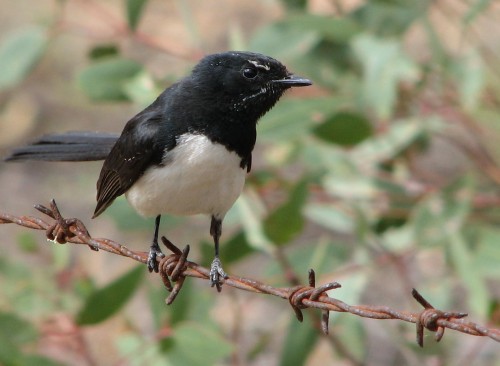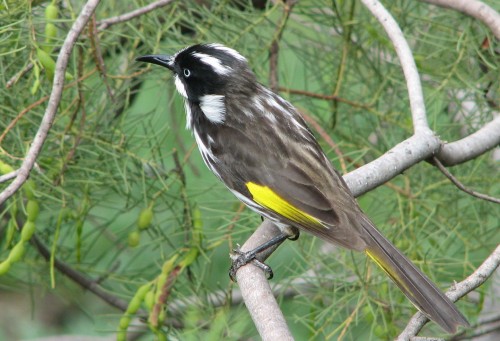Weird looking honeyeaters
We get a great deal of pleasure in watching the wide range of birds in our garden. Their favourite spot would have to be the bird baths. Ours too. I’ve strategically placed the bird baths where we can sit or eat our meals and watch the passing parade of birds visiting for a drink, especially on hot summer days. The list of species we’ve seen visiting the water is long and growing one.
Possibly the most frequent visitors are the resident New Holland Honeyeaters. They tend to come in numbers, sometimes a dozen or more at a time and they are always noisy, especially when they are bathing and not just drinking. Their splashing looks like a mini-sprinkler is sitting on the bath, water spraying everywhere.
A few days ago I captured these endearing shots of several having the time of their lives. Methinks they are in serious need of a hair – er – feather dryer.
I’ve included a few more photos of them below.
Good birding.
Further reading:
- Time for a bath – a list of the species visiting our bird baths
- Great birding moments
- New Holland Honeyeater
- New Holland Honeyeater nest
New Holland Honeyeaters feeding
We have many Australian native plants in our garden, and on our property. They are a magnet for the many honeyeaters we have resident around the garden.
I particularly like the many varieties of Eremophila we have growing, as these seem to flower for long periods of time creating a steady supply of food for the birds. The species shown in the photos above and below is Eremophila youngii which particularly appeals to the New Holland Honeyeaters that frequent this particular plant. An added bonus is that we can see this plant and the birds coming to it from the spot where we usually eat our meals and read the daily paper. It is also a few metres from the bird bath, another attractive part of the garden for our bird friends.
Further reading:
- Mallee Native Plant Nursery – eremophila – from the archives of my wife’s blog.
- Eremophila youngii – article on my wife’s blog
New Holland Honeyeaters
Last week we went for a short picnic lunch to the Pangarinda Arboretum at Wellington East, South Australia.
The breeze was cool – it is winter after all – but the sun was pleasant if you were out of the wind. While we had our lunch about half a dozen Welcome swallows entertained us by swooping all around. Two of them seemed to be having a race (breeding behaviour?) and as they swept past me they nearly collided with my nose.
While there were plenty of plants already flowering this spot will only come into its own in the coming month of so. Many plants were not yet flowering. Despite that the birds were already busy feeding on those plant that were in flower. The New Holland Honeyeaters, Red Wattlebirds and Singing Honeyeaters were particularly active everywhere through the park. We only stayed several hours but it was a pleasant diversion from the intense writing I have been doing over the last few weeks.
Another unusual visitor to our bird bath
In recent times I have written about the behaviour of various species of birds at the bird baths we have in our garden. The birds give us many hours of entertainment as they come to drink and bathe. The very hot weather we have been having this summer helps to encourage their frequent visits.
I also wrote recently about some unusual visitors to the bird baths, a Stumpy Tail Lizard and a Red Fox.
A few days ago I was alerted to the alarm calls of a flock of New Holland Honeyeaters near the bird bath. I quietly went to have a look. The NHHEs were soon joined by several Singing Honeyeaters and a family of White Browed Babblers. All were calling madly and looking at the ground near a bush.
I waited for a few moments, fully expecting a Brown Snake (highly venomous) to emerge from the undergrowth. I had my camera at the ready and my feet ready to take off if a hasty retreat was in order.
To my great relief it was only a Blue Tongue Lizard. With the stripes on the back and tail, and a thin, long snake-like tail we have often been fooled into thinking we have a Tiger Snake (also quite venomous) in the garden. (They actually look nothing like a Tiger Snake; it’s the stripes that catch you by surprise every time.)
The new visitor didn’t wait to have a drink. A slight movement from me sent it slithering – almost snake-like – into the undergrowth again.
Related articles:
- Some unusual visitors to our birth bath – with photos.
- Time for a bath – with more photos
Updated November 2103
Aggressive Bird Behaviour in the Garden
While working in the garden yesterday morning I was suddenly alerted to a noisy confrontation nearby. Our resident Willie Wagtails love to frequent one particular spot where there is an abundance of insects.
Suddenly a New Holland Honeyeater dived in to reap his share of the smorgasbord. The Willie Wagtail became quite aggressive, fanning his tail up high, ruffling the feathers all over and calling in what seemed to me to be in quite an angry – perhaps even distressed – way.
The honeyeater retreated to a nearby tree, only to swoop in repeatedly over the next few minutes. Each time the honeyeater would snap at the Willie Wagtail, zip away a metre or so, grab another insect, and retreat hurriedly to the refuge tree.
These attacks seemed to trigger even more aggression in the Willie Wagtail who decided to front up to the interloper. They then faced each other at about ten paces (bird step size – about 10cm) angrily calling in each others’ face. One last beakful of food and the New Holland Honeyeater decided that other parts of the garden were more attractive anyway, and it flew off. The Willie Wagtail continued to feast contentedly on his little patch.
Further reading:
- Aggressive birds – articles from my archives
This post updated in September 2015.











